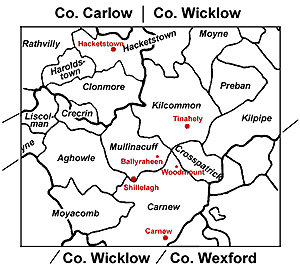born c. 1770's
1790's

See map of the parishes of
the southern borders of Wicklow, Carlow and Wexford Cos.
1795
| Second Generation
born c. 1770's |
The next evident generation of |
| These men, and their fathers, lived through a most violent period of Irish history -- the Insurection of 1798 . Some would argue that they also participated in the anarchy that swept through their unique corner of Ireland. Others would observe that the participants were simply defending themselves and against the wickedness of the other. The actions carried out both by the poor tenant farmers with their liberal backers, and the established gentry with their conservative agents, were certainly most concentrated in their wickedness. It was culmination of years of religious persecution, mutual fear and distrust, and the gradual moves towards equality. | |
| Histories: 1780's, 1790's | |
| Insurrection
builds
1790's |
Every two or three decades Ireland was visited by a major conflict -- the growing pains of a nation conceived in two parts: conservative and liberal, or as often described: Protestant and Catholic. The 1790's saw the most violent outbreaks of killing and torture in a century, and although the Insurrection of 1798 affected the whole island it was most extreme where there was the greatest animosity between Protestant and Catholic, Conservative and Liberal, Loyalist and Revolutionary. This was the south of County Wicklow and the County Wexford, home of our Mortons. |
 See map of the parishes of the southern borders of Wicklow, Carlow and Wexford Cos. |
|
| Many of the Mortons of Tinahely at that time were 'small gentry', squireens, or middlemen -- gentlemen farmers that did not own the land, but managed it for the often absent English landlord; typically farming on small plots and subleasing the rest. Tinahely was part of the vast Coolatin Estate owned by the 2nd Earl Fitzwilliam, William Wentworth (1748-1833). It was Fitzwilliam's actions as Lord Lieutenant of Ireland that some consider a turning point in the tensions that had been building for decades. | |
| Fitzwilliam
episode 1795 |
In January of 1795, Earl Fitzwilliam was appointed Lord Lieutenant following a change in the English governing party. Accountable to the cabinet in London, Fitzwilliam was responsible for managing the Dublin parliament as the chief governor of Ireland. Instead, he imposed his liberal and reformist views on parliament by supporting Grattan's Catholic relief bill and dissmissing two opposing senior officials. |
| Fitzwilliam had been described as a landlord sympathetic to his Catholic tennants and the plight of the religiously oppressed in Ireland. His friendship with and support of reformer Henry Grattan was well known. It was only two years earlier that Catholics had been given the right to vote, and this triumph promoted the efforts of the growing Society of United Irishmen. They desired armed rebellion as a means to reform. Fitzwilliam was instructed by his English government to not openly support reform, but remain reactionary and only vote for reforms if raised in parliament. He, instead, fired two members who lead the fight against reform, and openly supported Grattan's relief bill in February of 1795. | |
| When King George III was informed of these developments by Fitzgibbon, one of the ministers fired by Fitzwilliam, Fitzwilliam was recalled and replaced. History accepts that Fitzwilliam overestimated his position, yet his removal brought protests from Catholics and Protestant reformers, and his replacement by Earl Camden heralded an era of further repression and opposition to reform. Opposing sides were drawn ever closer to conflict, and our Morton ancestors were in the thick of it. | |
| Ingredients are mixed | We know the Mortons's landlord Fitzwilliam was a reformer, but for a few exceptions, we know little of the politics of the Mortons themselves. In southern Wicklow and Wexford Counties many opposing sides existed, and in greater concentration than the rest of Ireland. |
| When time for more research allows, I'd like to explore the role the Mortons played in the 1798 Insurection, including the two Mortons who were yeomanry captains killed at the Battle of Ballyraheen (Ballyhrahan). Other topics could include the rebuilding of Tinahely by Earl Fitzwilliam after it was burned, and the source of the third Generation of Tinahely Mortons. MB | |
|
|